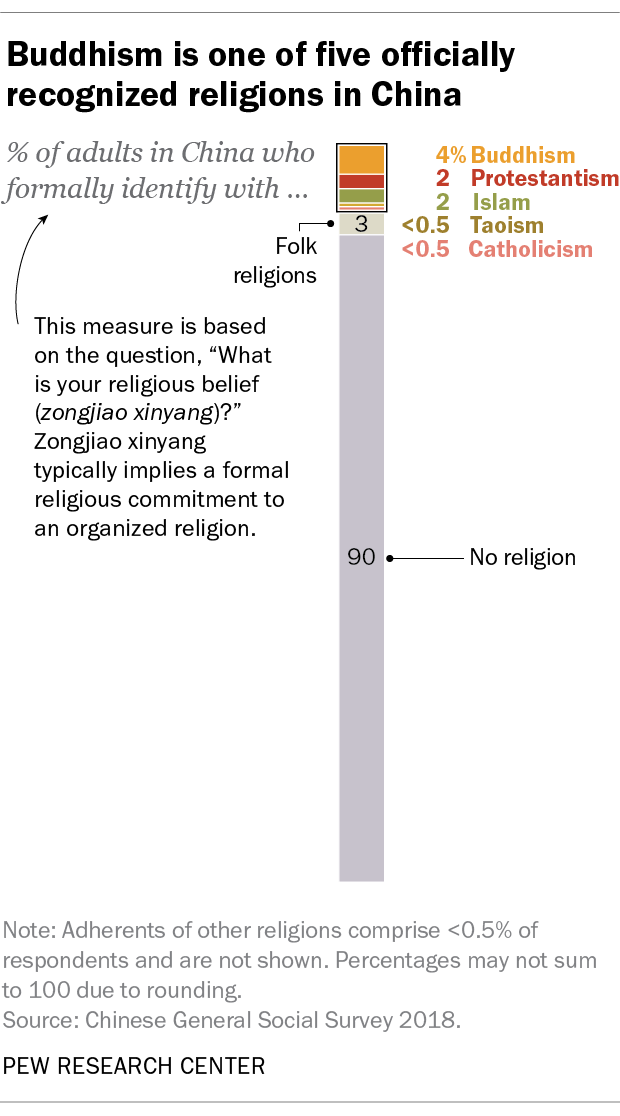
Buddhism originated around the fifth century B.C.E. in India, but today, more Buddhists live in China than India. Han Buddhism, the dominant branch of Buddhism in China, has blended with local belief systems including Taoism and Confucianism over the centuries and is now viewed as part of traditional Chinese culture.
Here are six facts about Buddhism in China, based on Pew Research Center’s recent report, “Measuring Religion in China.” The report analyzes surveys conducted by academic groups in China and Chinese government data on registered Buddhist temples.
This analysis examines the extent and diversity of Buddhist belief and practice in China. It is based on Pew Research Center’s August 2023 report, “Measuring Religion in China.” Both this analysis and the report draw on two nationally representative surveys conducted by academic groups in China: the 2018 Chinese General Social Survey and the 2016 and 2018 waves of the China Family Panel Studies survey. We also use data on registered Buddhist temples from China’s National Religious Affairs Administration website, accessed July 2023.
Buddhism is the most common religious identity in China, yet few people identify as Buddhist. Just 4% of Chinese adults – or 42 million people – formally identify as Buddhist and only 10% identify with any religion, according to the 2018 Chinese General Social Survey.

However, formal affiliation doesn’t reflect the full extent of Buddhist belief and practice. In China, many people who engage in Buddhist beliefs and practices do not identify as Buddhist – because they practice Buddhism alongside Taoism or folk religion, because they believe only monks or nuns have the right to call themselves Buddhist, or because Buddhism does not require formal affiliation.
For more on Chinese conceptions of religion, read “What ‘religion’ means in China” in the recent report.
A third of Chinese adults believe in Buddha and/or bodhisattvas, according to the 2018 China Family Panel Studies (CFPS) survey. In Buddhism, a bodhisattva is an enlightened being who has chosen to stay in contact with the mortal world to help others.
This group includes 17% of Chinese adults who believe in Buddha and/or bodhisattvas alongside other deities such as Taoist “immortals,” Jesus Christ, Allah or Tianzhu (the word Chinese Catholics use for God), according to the CFPS survey. Only 16% of Chinese adults believe exclusively in Buddha and/or bodhisattvas.
However, the Chinese word for “believe in” used in this question – xiangxin – doesn’t necessarily imply worship, so respondents may simply be saying they believe in the concept of Buddha (or other deities).
Many Chinese who say they believe in Buddhist deities may believe in their folk religious form. In China, mixing of beliefs is common, especially between traditional religions. For example, the bodhisattva Guanyin (known in Sanskrit as Avalokiteśvara) is worshipped in China both as a bodhisattva and as a folk religion goddess who grants prayers for things like health, wealth and giving birth to a son.
Buddhism is deeply intertwined with Taoism, Chinese folk religion and Confucianism. For example, 35% of Chinese adults burn incense to worship Buddha or other deities at least once a year, and 11% do so at least once a month, according to the 2016 CFPS survey. While this question specifically mentions Buddha, it is understood to refer to burning incense to pay respects to a range of deities, including Taoist immortals and folk deities such as Mazu and Guan Gong.
Buddhists also generally espouse the Confucian ideal of filial piety and have adopted practices that align with the Confucian tradition of ancestor worship, such as praying for the well-being of deceased ancestors.
The vast majority of Chinese Buddhists follow Han Buddhism, a branch of Mahayana Buddhism that has intermingled with other Chinese belief systems for centuries. Han Buddhism was promoted by multiple emperors, especially during the Tang dynasty (618-907), which helped it spread across the country. Currently, more than eight-in-ten registered Buddhist temples in China are Han Buddhist.
Tibetan Buddhism and Theravada Buddhism are practiced primarily by ethnic minorities in remote regions in southwestern China. Like Han Buddhism, they have incorporated beliefs and practices associated with those regions and ethnicities. Tibetan Buddhism incorporates aspects of Bon, a traditional religion of Tibet. Most communities that practice Theravada Buddhism also have forests that are believed to be the sacred homes of gods and ancestral spirits.
Worship practices in each of the three Buddhist branches include making offerings like incense, food and flowers; chanting sutras; and meditation.
Buddhism is one of five religions that the Chinese government officially recognizes, along with Protestantism, Catholicism, Islam and Taoism. During the Cultural Revolution (1966-1976), all religion was banned, including all branches of Buddhism. Today, the Chinese government enforces a policy of “Sinicization” – which, among other things, requires foreign religions to adapt to Chinese culture and traditions. The government celebrates Han Buddhism for having integrated Confucian, Taoist and other traditional Chinese beliefs and practices.
However, the government also scrutinizes many Buddhists, especially Tibetan Buddhists. Chinese authorities have been accused of carrying out “political re-education” campaigns meant to force allegiance to President Xi Jinping and discourage loyalty to the exiled Dalai Lama. In the last few years, the Chinese government has been criticized for tearing down Tibetan Buddhist monuments, including monasteries and statues.
